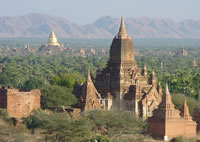 ®
® ®
®
| Bagan, Burma's Lost City by John Goss |
all images copyright © 2002 by John Goss |
We descended from the sky as the hazy light of dawn pierced the ruins of a lost city below. Stretching across this dusty plain were myriad shadows of shimmering spires and mountains of sandstone and red brick, incredible sacred shrines, more than 2000 of them according to archeological surveys. This vast mirage is all that remained after the armies of Kubla Khan sacked and burned a city that was once the richest and most refined in Asia. We touched down in Bagan, already in awe of its enormous scale and the shadow of its history that stretches across time itself. Many of the best-preserved monuments are located in an area designated as the Bagan Archeological Zone and that is where we began our exploration. Many of Bagan’s Buddhist zedis (stupas) contain vaulted interior chambers with spectacular Buddha images and iconography. These peaceful chapels are cool oases that became a welcome respite as the sun climbed higher in the sky. Shoes and socks must be removed before entering or climbing a shrine. Many of the monuments are multi-leveled, with stairways leading to awesome vistas of ancient structures stretching, almost infinitely, into the distance. The largest monuments where erected by Bagan’s kings and were built to impress. Monumental arched doorways support tons of brick and delicately rendered sandstone carvings. Antechambers painted with thousands of meditating Bodhisattva incarnations are protected by enormous guardian angels whose delicately curved hands kept worshippers from the inner sanctum. There, priests and aristocratic dynasties prostrated themselves in front of visages which gleamed from the shadows via natural spotlights of strategically placed skylights. Our guide pointed out that the expression of one towering Buddha was skillfully carved so that its expression changed from serious to mirthful contemplation as we approached the altar, a magical effect no longer restricted to those of royal blood. 800-year-old murals adorn many of the shrine interiors. Wizened caretakers turn on bare light bulbs in homemade lanterns to illuminate fragile, delicately painted panoramas. Scenes from everyday life mix together with episodes from the life of Buddha and the ritual celebrations of a devout and wealthy empire that created them. Observe carefully and you will discover discreetly sensual depictions of human interaction and decorative motifs inspired by lush gardens that once graced this grand city. The local market provides a pleasant change of pace from temple-viewing. Hunt among the stalls for local crafts and folk art, musical instruments, and Burmese puppets. Hawkers from regional ethnic tribes, in colorful traditional apparel, come here to sell their wares. Impressive heaps of fresh produce look delicious, including mounds of ruddy tomatoes and curious provincial vittles. Hop onto a horse-drawn carriage for a charming tour of the village. Bagan is also famous for its refined lacquer ware. Many of the lacquer craftsmen have moved to a single location, which makes for an easy survey of their workshops. Indigenous designs are abundant, from pumpkin-shaped soup bowls to delicately inscribed plates and boxes, etched by artisans to reveal the vivid colors of layer-after-layer of hand applied lacquer. There are also a number of surprising contemporary techniques being employed to make showpiece furnishings that would stand out in any sleek, modern home or office. At the end of the day, we climbed up to the top of one of the eastern temples, to quietly absorb the light of magic hour. Down on the dusty lanes, shepherds drove their goats back towards their pens and oxcarts trundled home from the fields. With just a little imagination we could picture Bagan as it once was -- a thriving metropolis of monasteries, markets, and homes amidst glittering, diamond-tipped pagodas and fantastical palaces flowering towards the sky. The sun descended lazily towards the mountains in the west, turning the Irrawaddy River into a ribbon of liquid gold. Everything around us, from the red dirt fields to the color of our skin, was warmly burnished to a coppery glow. Deep in reverie, we realized that the glory of lost Bagan is still very much alive.
|
 An ancient city, lost in time.
|
HOTELS IN ASIA + UTOPIA MEMBER DISCOUNTS + GALLERY AIDS/HIV INFO + ASIAN NEWS ARCHIVE + SAFER SEX + TRAVEL TIPS ADVERTISE + ABOUT UTOPIA + EMAIL US
Australia
+ Bhutan
+ Cambodia
+ China (including Hong Kong, Macau, Tibet)
+ East Timor
+ India
+ Indonesia
+ Japan + Korea
+ Laos All original text, images and content (c) 1994-2025. Utopia is a Registered Trademark. 乌同邦 |